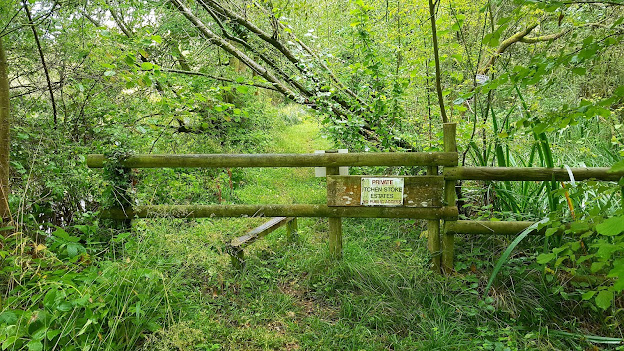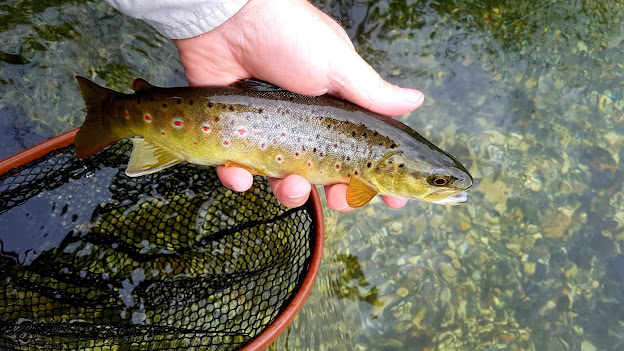The River Itchen is often described as the 'prince of chalkstreams'. It certainly has a rich and illustrious place in the annals of flyfishing literature. Some even regard the upper Itchen to be the finest trout water in the world. To say it has been a long held dream of mine to fish the upper Itchen would be putting it too lightly. The problem has always been how to access the river's upper reaches where the trout are bright and wild, and where the busy M3 motorway, a constant companion of the river's middle and lower reaches, doesn't intrude on the senses. There is just so little of it, something in the region of three miles of river. This prime water is as rare as seeing a swallow in the winter and the privilege of fishing it on a day ticket basis comes at great cost. One beat near the village of Itchen Stoke is available to the itinerant angler for the hefty sum of £480 a day. After a little bit of resolute digging I found my fishing nirvana - a beat at Itchen Stoke leased by the famed Piscatorial Society of London. By booking two nights at a local accommodation, I trumped the Society's esteemed members and acquired the right to fish these hallowed waters at a substantial discount. The accommodation was obviously popular. I had to wait months - until the first weekend of September - for the first and only available vacancy this year. I made a weekend break out of it.
I watched the long range weather forecast like a hawk in the two weeks leading up to my visit. It had initially been touch and go for a day of rain, but as my day approached and the forecast became a little more reliable, the outlook settled upon a cool day of cloud cover and a gentle breeze. I could live with that.
We arrived and settled in to our accommodation in the early evening. Despite the cold air and a gentle rain my partner and I went for a short walk to peer over a bridge into the nearby Candover Brook, one of the main head water tributaries of the Itchen, where a row of picturesque thatched cottages stood. A trout spooked at my presence and bolted for the cover of the bridge. Looking upstream, a grey heron stalked the margins. It was a pretty English scene, and it reminded me of a John Constable painting. We made it back to our cottage just as a heavy downpour fell from the clouds. The rain continued deep into the night, the rhythmic patter on the cottage roof lulling me to sleep. I hoped that I would wake to clear skies.

The sky was a sullen grey when I woke, but fortunately the rain had ceased. The land was heavy with moisture and large puddles of rain water dotted the single track country lane to the river. I met the estate's young game keeper at the beat's car park at 9 am. I was to fish beat 2, known as "The Shallows", reached by following a footpath running beside the 1st "Home" beat. It gave me a good chance to view this magnificent river, a quilt patchwork of golden gravels, brown silt and blends of luminous and deep green water weeds. In the ribbons of clear, shallow water running over gravel, trout were boldly visible. The slight yellowing of the riverside leaves announced the onset of Autumn. A gentle rain began to fall, but it failed to dampen my excitement. The Itchen must be one of Britain's prettiest waterways. Unquestionably, it is one of Britain's most precious.
 |
| My first glimpse of the Itchen - looking upstream from the start of the Home beat |
 |
| Looking downstream from the start of the Home beat |
Still mesmerised by the river's beauty, I slipped into the cold water at the start of my beat. I spotted a trout lying behind the trailing branches of a bush but after several casts, it melted away. I realised then that the task ahead wasn't to be an easy one. These fish had their wits about them.
The low light under the grey clouds made it hard to spot fish. There was also a strong glare reflecting from the water. It was virtually impossible to see fish directly upstream of me, so I had to improvise. There weren't any rising trout so I attached a small tuft of white wool to my leader as an indicator and cast speculatively into the likely water, inching upstream between casts. It isn't an ideal approach on a chalkstream, but it paid off around ten minutes later when I landed my first brown trout from the Itchen. It was a lovely little fish of ten inches.

The fishing proved to be rather challenging thereafter. I witnessed a couple of fish spook at my presence from a long way off, and several more seemed to spook at the mere sight of my leader, indicator or fly. I replaced my 9' leader for a 12' version, and added 3' of tippet. This seemed to help, because I caught another trout with a nymph soon after the change. The river here flowed quickly, through a series of two sweeping bends, and as I approached the long, relatively straight stretch of water above, I realised it was almost 12.30 pm. Two trout in three hours seemed too modest a reward, and I began to scratch my head for ideas. But then I witnessed the very welcome sight of a fish rising a little way upstream. I replaced the nymph with a small Parachute Adams, and landed three trout in quick succession. I was a lot happier with my tally when I paused for a pasta salad lunch on the banks of the river.

The Shallows beat is only around 250m long but it has two distinct sections. The swifter flowing section I describe above, and a long straight section where the river is wider and flows a little more sedately. There seemed to be more fish in the latter section and a greater proportion of grayling. I could also spot them a little easier in the calmer water. By 4.30 pm I had reached the upper limit of the beat, with a tally of ten trout and ten grayling. The best of each species were around twelve or thirteen inches long. I spotted the largest trout and watched it turn and take my nymph (I'm beginning to really enjoy the thrill of sight nymphing). The grayling were all a beautiful shade of gold, and their undersides were seasonally coloured with yellow lines. I was in seventh heaven.

All of the fish in the afternoon had taken a nymph, and the majority of those had taken a fly I had tied myself before this trip. Intended to represent a shrimp, it was tied on a size 16 hook with a 2 mm gold tungsten bead head, a body made up of a blend of Donegal olive and pink seal's fur dubbing, and a head section of glitzy olive antron. Both the trout and grayling seemed quite happy to take my creation, and it did wonders for my renewed interest in tying my own flies.


Along the way, I spotted the largest pike I have ever seen. I turned to look into a sheltered bay of calm water to my left and jumped out of my skin when I saw it. You really don't expect to see any living creature of such proportion in a chalkstream. I would estimate it to have been around 50 inches long but now I question my memory, because from what I can tell from an internet search, that would be a very large pike indeed. There were two smaller pike, each around 30 inches long, resting in the same bay. They are menacing looking things.

I was cold and drenched thanks to a leak in my waders, and for a split second I pondered calling it a day. I decided against going home, and walked back to the mid way point of the beat and fished the better second half of the river again. I caught six more trout and another grayling. I'm very glad I persisted because the last of them was the best fish of the day, caught just on the stroke of 7 pm as the light began to fade. I knew I had hooked a special fish when it stripped line from my hands. It was a chunky, mature looking trout of fifteen inches, and its capture really made my day!

If anything, I was a little disappointed that I didn't encounter a hatch and a sustained rise, but that was only a small grumble (and an increasingly common theme when fishing chalkstreams in modern times). How can anyone complain about catching good numbers of fish from such a renowned and beautiful river? I had finally experienced the Holy Grail of fly fishing. It felt special that these were all wild fish and it showcased what chalkstream fishing really should be about (take note, heavily stocked River Test!). My dream was achieved and now I can only think about visiting again soon.











Justin
ReplyDeleteAnother beautiful stream you were fishing, is that moss on the surface. I am wondering how these private streams keep quality trout in them year after year? I assume most all are native trout, but are some of these streams stocked. Most all the streams in the southern U.S. are stocked with the exception of the mountain stream where the native trout still exist. Heavy fishing pressure keeps most of the quality trout taken and so every month the streams are stocked. There are places in Georgia, North Carolina, and Tennessee that require the angler to either pay or get permission to fish some private sections of streams in these state. In fact President Carter fished some private streams in Georgia when he was younger. Enjoyed the read thanks for sharing
Hello Bill. Thanks for leaving a comment. I think you are referring to the water weeds, commonly water crowfoot and starwort in chalkstreams. Chalkstreams are a productive environment and can sustain a large head of trout. Some like the upper Itchen are sustained by natural recruitment only, but many others are heavily stocked. Access to all of them is tightly controlled, usually by prohibitive cost, so fishing pressure is managed.
ReplyDelete